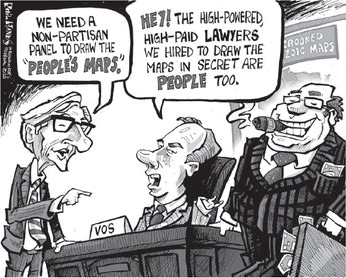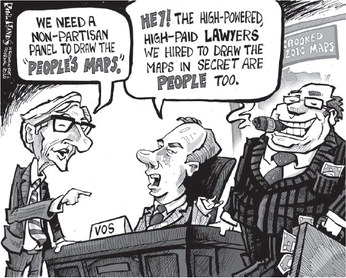Wisconsin needs to take party politics out of redistricting


When it comes to politics, Wisconsin is a very purple state.
In some elections and on some issues the state swings toward Republican red and at other times and with other issues it swings toward Democrat blue. Surveys of Wisconsin voters and the evidence of recent statewide elections finds the mix is about even between the two major parties.
Even as individuals, voters, especially at the local level, tend to look toward the substance of what a candidate stands for rather than any party affiliation. While most people could name their sheriff or county clerk, very few would remember, or care about, their party affiliation. This is something that Wisconsin does right.
The logical outcome of such a mixed population would be a mixed legislature where neither side had an overwhelming majority and where working together for the common good of all is the priority.
This Polyanna-esque dream is about as far from current political reality as Dorothy and Toto are from Kansas in the Wizard of Oz. Instead we have seen lopsided legislatures where thanks to backroom redistricting, one party or the other has enjoyed outsized majorities and use these to justify ignoring the opposition party’s positions.
When writing the U.S. Constitution more than 230 years ago, the framers decreed that every 10 years the number of people in the country would be counted and that the population totals would be used to determine seats in Congress.
In 1964, in the Reynolds v. Sims case the U.S. Supreme Court established the principle of “one-person, one-vote” requiring state legislative districts to be apportioned equally so that votes would have equal weight.
This has an impact on every level of government from city council and county board to the state legislature and congressional districts.
In Wisconsin, the legislature has historically set its own district boundaries. Or more precisely, the party in power at the time the redistricting occurred drew district boundaries that ensured they would continue to stay in power by creating supermajority districts where their opponents were concentrated and where their own power base was strongest.
Wisconsin needs a better, nonpartisan way of drawing its legislative maps.
Gov. Tony Evers’s executive order creating an ostensibly politician-free “People’s Maps Commission” to draw new districts following the 2020 census, is a good step in that direction. It is modeled on Iowa’s nonpartisan redistricting system which has been in place since 1980. Under Iowa’s system, districts are drawn by nonpartisan legislative staff with a final vote in the legislature.
The unfortunate reality in Wisconsin politics is that if Gov. Ever’s office supported the sun rising tomorrow, Assembly Speaker Robin Vos would issue a statement condemning sunshine and its ill-effects on the vampire lobby.
When it comes to redistricting, neither political party has done a good job. It is time to toss out the political games and focus on ensuring every person’s vote matters.


